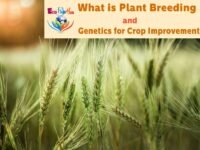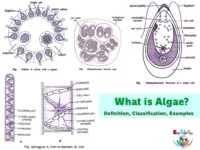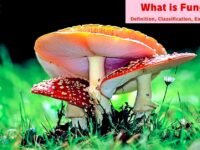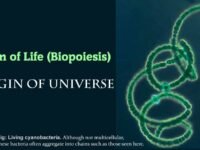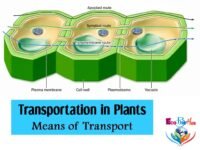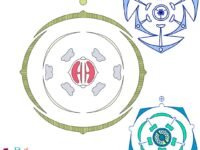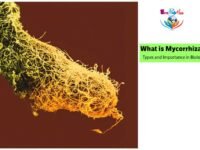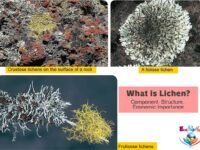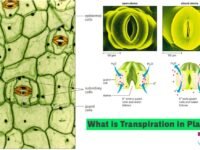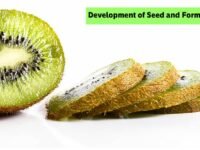In this tutorial, we have described secondary growth in Plants (stems and roots).
TABLE OF CONTENTS
WHAT IS SECONDARY GROWTH
The increase in thickness or girth due to the activity of cambium and cork cambium is known secondary growth. In a typical dicot stem, secondary growth starts in interstellar region and extends towards the extra-stelar region. In stelar region, it starts owing to the activity of cambium and in extrastelar region due to cork cambium.
The activity of vascular cambium forms secondary vascular tissues and cork cambium or phellogen forms periderm. The secondary tissues form the bulk of the woody plants and help in the protection, support, and conduction of water and nutrients.
SECONDARY GROWTH IN STEM
An Overview of Secondary Growth in Dicot stem
On the basis of the activities of cambium and cork cambium, secondary growth in the stem can be discussed under the following heads:
1. Activity of the Vascular Cambium
(i) Formation of Cambium Ring:
The vascular bundles of a dicot stem have strips of cambium in between xylem and phloem which are known as intrafascicular cambium. During secondary growth, cells of medullary rays in line with the intrafascicular cambium develop meristematic activity and form strips of cambium called interfascicular camibum. The intra and interfascicular cambium unite a complete ring called the vascular cambium ring. The activity of the cambium ring gives rise to secondary growth.
Cambium has two types of cells:
(a) elongated spindle shaped fusiform initials form fibres, sieve cells, sieve tubes, tracheids, and
(b) shorter isodiametric ray initials which produce parenchymatous cells of the rays in wood and phloem.
TABLE: Differences between Intrafascicular and Interfascicular Cambium
| Sl. No. | Intrafascicular Cambium | Interfascicular Cambium |
| 01. | It is a primary meristem. | It is a secondary meristem. |
| 02. | It is present in the primary stem within the vascular bundles. | It develops at the time of secondary growth. |
| 03. | It is derived from procambium of apical meristem of the stem. | It develops from permanent cells of primary medullary rays through differentiation. |
(ii) Formation of Secondary Vascular Tissues:
The cambium ring becomes active as a whole and starts cutting off new cells by periclinal divisons. The cells cut off on the outer side get differentiated into the phloem and are called secondary phloem. The cells cut off on the inner side are modified into the elements of the xylem which constitute secondary xylem.
Secondary phloem consists of sieve tubes, companion cells, phloem fibres, and phloem parenchyma. Secondary xylem consists of thickened vessels (scalariform and pitted), tracheids, xylem fibres, and xylem parenchyma.
Since the cambium is more active on the inner side, the xylem increases more rapidly in bulk than the phloem and forms a compact mass. Due to the continued formation of secondary xylem and pressure exerted by it, the cambium, phloem and surrounding tissues are gradually pushed outwards. Though some primary tissues get crushed but the primary xylem remains intact in or around the centre.
The bulk of secondary xylem is referred to as wood and its width increases with the age of the plant.
(iii) Formation of Secondary Medullary Rays:
Certain cells of cambium form some narrow bands of living parenchyma cells passing through secondary xylem and secondary phloem and are called secondary medullary rays. They provide radial conduction of food from the phloem, and water and mineral salts from the xylem.
(iv) Formation of Annual Rings:
 – In regions with distinct seasonal variations, i.e., favourable (spring or rainy) and unfavourable (autumn, winter, or dry summer) the cambium activity is not uniform. During favourable seasons when the temperature, sunshine, and humidity are optimum, the need for sap transport is acute to increase in production and activity of foliage leaves. Therefore, cambium is more active forming a greater number of vessels with wider cavities or larger, pitted vessels.
– In regions with distinct seasonal variations, i.e., favourable (spring or rainy) and unfavourable (autumn, winter, or dry summer) the cambium activity is not uniform. During favourable seasons when the temperature, sunshine, and humidity are optimum, the need for sap transport is acute to increase in production and activity of foliage leaves. Therefore, cambium is more active forming a greater number of vessels with wider cavities or larger, pitted vessels.
– On the contrary, during unfavourable seasons or inactive period, there is less demand for sap transport as cambium is less active, and consequently narrower elements are formed. In tropical areas where only one kind of season prevails i.e., long dry summers, distinct rings are not formed.
– The number of annual rings as well as the width of rings formed in successive years vary greatly in plants.
– The wood formed in spring is known as spring wood or early wood and that formed in dry summer or cold winter as autumn wood or late wood. The spring wood is lighter in colour and has a lower density; whereas autumn wood is darker in colour and has higher density.
– These two types of wood appear together as concentric ring known as annual ring in the transverse section of stem. A
sharp contrast between late autumn wood and early spring wood makes the successive rings distinct even to naked eye.
– The transition from spring to autumn wood is gradual but the transition from autumn wood to spring wood of next year
is sudden.
– The annual or yearly growth of wood in the form of distinct concentric rings are called annual rings. Distinct annual rings are formed in areas with distinct climatic variations i.e., experiencing two seasons, which affects the uniform activity of cambium throughout the year.
– As each annual ring corresponds to one year’s growth.
– The age of a plant can be approximately determined by counting the number of annual rings. It is called dendrochronology.
The branch of biology dealing with the determination of the age of a tree by counting the number of annual rings is termed as dendrochronology. Annual rings also tell us the climatic conditions through which a plant has passed.
2. Activity of Cork Cambium (Formation of Periderm)
The marked increase in the diameter of the stem due to secondary thickening exerts great pressure on the outer tissues. This results in the rupture of the cortex and epidermis. As a result, the outermost layers of the cortex become meristematic and begin to divide. This is called cork cambium or phellogen.
Cork cambium forms secondary tissues but its activity is more on the outer side than on the inner side. Cells formed on outer side constitute cork or phellem and those on the inner side secondary cortex or phelloderm. Secondary cortex consists of living parenchyma cells.
All the three tissues formed consisting of phellogen (cork cambium), phellem (cork), and phelloderm (secondary cortex) are together known as periderm.
(i) Cork:
The new cells produced by phellogen on the outer side are roughly ractangular in shape. They soon become dead and suberised due to the deposition of suberin. These cells constitute cork or phellem of the plant. The cork cells are usually brownish in colour and arranged in radial rows. Being suberised, cork cells are impervious to water and hence protect inner tissues from the attack of fungi and insects.
(ii) Bark:
All dead tissues lying outside the active cork cambium are collectively known as bark. This includes the ruptured epidermis, hypodermis, and cork. When cork cambium appears in the form of a complete ring, it is known as ringed bark. E.g., Betula. If cork cambium occurs as separate strips and the resulting bark appears in the form of scales, such a bark is known as scaly bark. E.g., guava.
Bark is protective in function. Bark protects against parasitic fungi and insects, prevents water loss by evaporation, and guards against variations of external temperature. It is insect repellent, decay proof, fire proof, and is used in obtaining drugs or as spices. E.g., Bark of Quercus suber is used for the manufacture of bottle stoppers, and of Cinchona is the source of drug quinine used in the treatment of malaria.
(iii) Lenticels:
These are aerating pores formed in the cork or bark of stems through which exchange of gases takes place. These occur on the surface of bark as small scars with a depression in the centre.
Lenticels usually develop below stomata of the epidermis. Each lenticel consists of a loose mass of thin-walled cells, called complementary cells. The phellogen below the lenticel, instead of producing cork cells, forms loosely arranged oval or spherical cells with intercellular spaces. These spaces communicate with the outside through the pore formed by the ruptured epidermis. The margin of the lenticel is surrounded and raised by cork cells.
In plants growing in temperate regions, lenticels get closed during winter months by the formation of cork. On the approach of spring, it gets ruptured.
■ Significance of Secondary Growth in Stem
1. It increases the girth of the plant so as to provide mechanical support to the increasing weight of aerial parts.
2. It replaces the old non-functioning conducting tissues and helps in the conduction of water and solutes to distant places in the plant.
3. The cork or bark protects the inner tissues from injury, heat, and cold.
TABLE: Differences between Phellem and Phelloderm
Sl. No.
Phellem
Phelloderm
01.
Phellem or cork is a tissue formed on the outer side of the phellogen.
Phelloderm or secondary cortex is formed on the inner side of phellogen.
02.
It is made up of dead cells.
It is composed of living cells.
03.
It is protective in function.
Its cells serve for the storage of food.
04.
Its cell walls are highly suberised and are thus impermeable.
Its cells are not suberised.
05.
The cells are filled with tannin.
Tannin is not found.
06.
The cells are compactly arranged.
The cells are loosely packed with small intercellular spaces.
Cork is a peripheral water-proof tissue formed in mature woody stems due to the activity of phellogen or cork cambium. Cork is made of dead, thick-walled, and highly suberised cells. The main source of commercial cork is the Oak tree (Quercus suber), a native of the Western Mediterranean region.
Spain, Portugal, France, Italy, Tunisia, and Morocco are the major cork oak growing countries. Quercus tree is 20-60 ft in height and about 4 ft in diameter. The commercial cork is harvested as sheets every four years.
Economic Importance of Cork
1. Cork cells being highly suberised and thick-walled, cork is protective in function.
2. It provides insulation from the freezing temperature of cold winter.
3. It protects the inner tissues from the attacks of microorganisms and prevents loss of water.
4. Lenticels found on the outer surface of cork help in the aeration of inner tissues.
5. Being light and highly compressible, it is put to several industrial uses.
6. Because of its impervious nature, it is used as a stopper for bottles.
7. Its recent uses are in the manufacture of insulation boards, shock absorbers, linoleum and sports goods, etc.
WOOD
Wood is a complex secondary tissue produced mainly in the stems of gymnosperms and angiosperms due to secondary growth. It is an important renewable raw material of the industry and was being used even before metals were discovered. Wood has contributed a lot to the advancement of civilisation.
Wood is a ready source of fuel, timber, shelter, tools, and furniture. It is cheap, light, and may easily be worked with tools.
Basically, wood is secondary xylem formed by the vascular cambium during secondary growth. Vascular cambium consists of two types of cells, the fusiform initials and the ray initials. Fusiform initials give rise to vessels, tracheids, xylem fibers, and axial parenchyma. Ray initials form the cells horizontal to the long axis of the stem and constitute the rays. The unctions of various elements of wood are:
1. Vessels serve for water conduction.
2. Tracheids function both in conduction and providing mechanical support.
3. Wood fibres mainly provide mechanical support.
4. Wood parenchyma is the only living component of the wood. It serves for the storage and distribution of carbohydrates.
Characteristic Features of Wood
Tissue components of wood show specific features which are of great significance in wood identification. Some of them are as follows:
1. Soft Wood and Hard Wood
– The wood produced by the gymnosperms is called softwood. In fact, the coniferous wood is quite hard but it is called soft because it lacks wood fibres. Softwood contains 90–95% tracheids and 5-10% ray cells. Softwood is also known as non-porous wood because it lacks the vessels (vessels look similar to the pores in cross section). The common examples of non-porous, soft wood are Pines, Spruce, Fir, and Deodar, etc.
– The wood of dicotyledonous trees is called hardwood or porous wood since it contains abundant wood fibres, vessels (sometimes tracheids also), and wood parenchyma. Tracheid content is very low (<5%). Examples of such wood are Kikar, Shisham, and Mulberry, etc.
There are two types of hardwood/porous wood – Ring porous and Diffuse porous.
Ring porous wood is considered to be more advanced than diffuse porous wood as it provides a better transition in case of high requirements by the plant.
– The softwood and hardwood can easily be distinguished by examining a transverse section of a log of wood even with a hand lens.
TABLE: Differences between Softwood and Hardwood
| Sl. No. | Softwood | Hardwood |
| 01. | It is called softwood because it lacks wood fibres. | It is called hardwood because it contains abundant wood fibres. |
| 02. | Softwood lacks vessels and hence the wood is called non-porous. | Hardwood contains vessels. Therefore, it is called porous wood |
| 03. | Softwood contains 90–95% tracheids. | It contains 5-10% tracheids. |
| 04. | It is found in gymnosperms. | It is found in angiosperms. |
2. Heartwood and Sapwood
– In old trees, secondary wood is differentiated into a centrally situated darker and harder wood called the heartwood or duramen and an outer light coloured zone called the sapwood or alburnum. Dark colour of heartwood is due to the deposition of tannins, resins, gums, essential oils, etc., in the cell walls and cell cavities.
– In addition to this, xylem elements of many woody trees are blocked by bladder-like ingrowths of neighbouring parenchyma cells thus blocking the cavities of vessels. Such bladder-like ingrowths are called tyloses. Owing to the plugging of the cavities, heartwood ceases the function of conducting tissue.
– It simply provides mechanical support to the stem. The sapwood which lies in the outer region of the secondary wood has living parenchyma cells and unplugged vessels. It functions as conducting tissue and also as a food storage tissue.
TABLE: Differences between Sapwood (Alburnum) and Heartwood (Duramen)
| Sl. No. | Sapwood (Alburnum) | Heartwood (Duramen) |
| 01. | It forms the central wood of an old stem. | It forms the outer wood of an old stem. |
| 02. | It is dark-coloured. | It is light-coloured. |
| 03. | It is heavier. | It is lighter in weight. |
| 04. | Living cells are absent. | It contains living cells. |
| 05. | It is the dead and non-functional part of the secondary xylem. | It is the functional part of the secondary xylem or wood. |
| 06. | It does not conduct water and minerals. | It carries out the conduction of water and minerals. |
| 07. | The tracheary elements are plugged by tyloses and other substances such as gums, resins, tannins, etc. | The tracheary elements are not plugged by tyloses and other depositions. |
Uses of Wood
1. Wood is a poor conductor of heat, electricity, and sound. In Japan and USA houses are made of wood. Such houses remain cooler in summer and warmer in winter.
2. Wood being lighter in weight, can be transported to distant places at cheaper rates.
3. Temperature does not affect the volume of wood.
4. Due to its porous nature, wood easily holds paints, varnish, lacquer, and other finishing materials.
5. Wood does not rust and is a better absorber of shocks and vibrations.
6. Wood can easily be converted into pulp which is used in the manufacture of paper, plastics, rayon, and transparent film.
7. Wood can easily be cut, shaped, peeled, and jointed by nails and screws.
8. Wood is attractive and appealing to the eyes.
Limitations of Wood
1. It cannot be rolled into new shapes.
2. It is combustible and ignites spontaneously at 275°C.
3. Physical and mechanical properties cannot be changed or improved by heating.
4. It is damaged by termites and decays easily.
TABLE: Differences between Early Wood and Late Wood
| Sl. No. | Early Wood (Spring Wood) | Late Wood: Autumn Wood |
| 01. | It is formed during favourable period of growth. | It is formed during untavourable period of growth. |
| 02. | It forms the major part of the annual ring, | It forms a narrow strip in the annual ring. |
| 03. | It occurs in the beginning of an annual ring. | It occurs at the end of an annual ring. |
| 04. | It contains large and wider elements. | It contains small and narrower elements. |
| 05. | Fibres are fewer. | Fibres are abundant. |
| 06. | It is lighter in colour. | It is darker in colour. |
| 07. | It has lower density. | It is of higher density. |
SECONDARY GROWTH IN ROOTS
• The formation of secondary tissue which leads to an increase in girth is called secondary growth. Secondary tissues are formed by two types of lateral meristems – vascular cambium (formed from conjunctive parenchyma and pericycle) and cork cambium or phellogen (formed from pericycle).
• The vascular bundles in dicot root are radial and 2 to 6 strands of xylem and phloem are present in a ring (Diarch to hexarch condition).
• During secondary growth, the parenchymatous cells below the phloem patches and later on outside the protoxylem groups, become meristematic and cambium like, due to which a complete ring of cambium is formed, which cuts off secondary tissues (secondary xylem and secondary phloem) and hence increase in girth or diameter of root occurs.
• Cork cambium activity in roots:
Just as in stem, cork cambium or phellogen layer is differentiated in pericycle or cortex, which cuts off few phellem cells on the outer side and phelloderm on the inner side and thus protective layer is formed (i.e., secondary growth by extra stelar cambium).
In certain species of rosaceae and myrtaceae a special phellogen is formed in pericycle of root or underground stem. This layer produces few non-suberised cells which alternate with suberised cells of endoderm. It is living and acts as a storage tissue. This complex tissue is called polyderm.
(01) Origin and Activity of Cambium
●At first, certain parenchyma cells of the conjunctive tissue lying on the inner side of the phloem bundles become meristematic and form strips of cambium.
●The cells of the pericycle also become meristematic and connect with the earlier formed cambium strips on either side. Thus, a continuous wavy ring of the cambium is formed which lies external to the xylem and internal to the phloem. The portion of cambium in the region internal to phloem becomes active first. It cuts off new cells both on the inner and outer sides. The cells formed on the inner side differentiate into secondary xylem and those on the outer side, into secondary phloem.
●More cells are added on the inner side than the outer side. Because of this unequal activity, primary phloem and cambium are gradually pushed outward and cambium forms a circular ring. Now the whole of the cambium ring becomes active and adds new cells both on the inner and outer sides.
Secondary Xylem
It forms main bulk of the root and consists of numerous thin-walled vessels, wood parenchyma, and a few fibers. Unlike woody stems, annual rings are rarely formed in roots. This is because of the fact that the roots are usually buried in the soil where they are not subjected to the changing conditions of the atmosphere.
Further, the primary xylem remains intact at the center even when secondary growth has taken place for a number of years.
Medullary Rays
The cambium cells against the protoxylem do not form either secondary xylem or secondary phloem. At these points, radial rows of parenchyma cells extending across the secondary phloem and xylem make their appearance. These are known as primary medullary rays. The medullary rays are more numerous in the root than in the stem. Sometimes, secondary medullary rays are also formed by the cambium.
Secondary Phloem
New cells cut off by cambium on the outer side form elements of secondary phloem. It consists of sieve tubes, companion cells, parenchyma, and a few sclerenchyma fibers.
Primary phloem gets crushed soon after the secondary growth starts and only secondary phloem persists in the form of a thin layer.
(02) Origin and Activity of Cork Cambium
Soon after the initiation of secondary growth, the single-layered pericycle becomes meristematic and forms cork cambium or phellogen. It cuts off cork outside and parenchymatous phelloderm or secondary cortex inside. The cortex and endodermis eventually get disorganized.
The epiblema dies out earlier. All these dead tissues are soon replaced by the dead bark. Thus, in a root with secondary growth, secondary tissue or periderm consists of cork, phellogen or cork cambium, and phelloderm or secondary cortex. Later on, here and there lenticels appear on the surface of the root as in the stem.
■ Significance of Secondary Growth in Roots
1. Secondary growth increases the thickness of roots and provides mechanical support to the increasing weight of the plant.
2. In the extravascular region, it produces cork bark to protect the inner tissues from injury, heat, cold, and infection.
3. It replaces old nonfunctional conducting tissue with the new one to meet the increasing demand for water and minerals by the growing plant
ANOMALOUS SECONDARY GROWTH
The term anomalous secondary growth is used to indicate the forms of cambial activity that deviate from commonly occurring secondary growth. The anomalies may be in growth in thickness, resulting in peculiar structures of xylem and phloem. An anomaly may arise on account of abnormal activity of normally positioned cambium or normal activity of abnormally positioned cambium anomalous growth varies considerably in different plants.
Anomalous Secondary Growth in Dicots
● Anomalous Secondary Growth in Dicot Root
Secondary growth begins with the formation of primary cambium. It is formed from the parenchyma cells between the xylem and phloem groups except opposite the two protoxylem groups where it arises from the pericycle. This cambium produces a ring of closely arranged collateral vascular bundles. It ceases to function.
The second cambial ring now develops from phloem parenchyma outside the first cambial ring. It forms secondary collateral vascular bundles. These are separated by radially formed secondary parenchyma. This cambial ring also ceases to function.
The third ring of cambium is now produced from the pericycle. At this stage, the pericycle divides and becomes many layered from which cambial rings develop successively. As a result, rings of vascular bundles alternating with storage parenchyma are formed. All the cambia are normal in behaviour producing xylem and phloem in the usual way but the outer cambia are progressively less active than the inner cambia. Consequently thinner rings appear in an outward direction.
● Anomalous Secondary Growth in Dicot Stem
In a stem, numerous vascular bundles occur in a ring embedded in conjunctive tissue scattered in the centrally located pith. In the beginning, there are numerous scattered primary vascular bundles. These bundles are collateral and open. The cambium of the bundles is active and individual bundles show a little amount of secondary growth. This activity stops after some time. These bundles come to lie in the pith and are now called as medullary bundles.
Secondary growth begins later with the development of a new cambium outside the stele. This cambium cuts off conjoint and collateral vascular bundles on the outer side. These are secondary bundles that remain embedded in the large amount of conjunctive tissue formed by the cambium. Many rings of vascular bundles are formed which remain embedded in the conjunctive tissue and their phloem consequently gives an appearance of included phloem or phloem islands at a number of places.
Anomalous Secondary Growth in Monocots
Though secondary growth is rare in monocots, it is commonly seen in woody monocotyledons like Dracaena, Yucca, Aloe, Agave, etc. In such arborescent monocot stems, the secondary cambium grows in the hypodermal region and forms conjunctive tissue and patches of meristematic cells. The latter grows into secondary vascular bundles.
In Dracaena at a very late stage during the development, a wide zone of the secondary meristem (cambium) develops outside the vascular bundles in the parenchymatous regions. This meristematic tissue cuts off vascular bundles on its inner side. These are concentric (amphivasal) in contrast to the primary bundles which are collateral. The amount of parenchymatous ground tissue also increases, therefore, the diameter of the stem. The cambium (meristematic zone) originates near the leaf primordia. The life of this zone or layer is limited. It stops functioning after some time and the adjacent cells take over.
Another important feature in contrast to the cambium of dicotyledons is that cambium in Dracaena cuts off both xylem and phloem on its inner side while on its outer face very little amount of parenchyma is produced.

